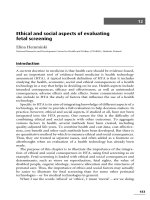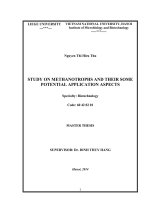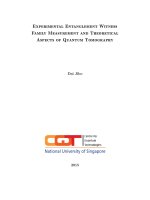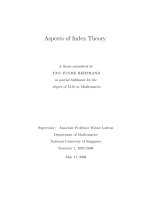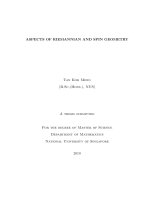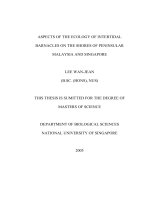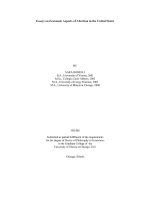ORGANISATIONAL ASPECTS
Bạn đang xem bản rút gọn của tài liệu. Xem và tải ngay bản đầy đủ của tài liệu tại đây (137.17 KB, 30 trang )
Section 4 – Organisational aspects
152 ANTENATAL EDUCATION
Women preparing for childbirth make use of many sources of information. These
will typically include discussion with other women, magazine articles, books and
classes. Classes may be run by the GP practice or maternity unit, or by external
bodies such as the National Childbirth Trust (NCT). Antenatal education is benefi-
cial, since it has been shown that the well-informed mother will cope better with
labour, but it is important that the information received by the mother should be
accurate, well balanced and relevant to local conditions (there is, after all, little
point in discussing the virtues of epidural analgesia if no such service is available
in the local hospital).
Much of the information given to mothers in the antenatal period is outside the
control of the anaesthetist and may well be inaccurate or misleading; it is therefore
particularly important for the anaesthetist to seek every opportunity to get his/her
message across.
Problems/special considerations
Retention of information
The middle of a painful labour is the wrong time to attempt to provide quite
complex information about regional analgesia. In addition to the pain itself and
the inevitable tension, the mother may well be under the influence of powerful
sedative/analgesic drugs. Theoretically, the antenatal period is the ideal time
to educate mothers about pain relief and anaesthesia for Caesarean section.
Unfortunately, many studies have shown that the ability of patients to recall details
of explanations is poor and that such information tends to be retained for the
short term only. This problem is exacerbated by the finding that around 50% of
primigravidae who have epidural analgesia in labour were not planning to use
it; these women would be especially unlikely to recall information given in the
antenatal period.
Analgesia, Anaesthesia and Pregnancy: A Practical Guide Second Edition, ed. Steve Yentis, Anne
May and Surbhi Malhotra. Published by Cambridge University Press. ß Cambridge University
Press 2007.
Written information
Poor recall of verbal explanations implies that antenatal classes should be supple-
mented with written information that mothers can take home and read at leisure;
audiotapes and videos can also be very helpful. When preparing these sources, it
is important to target them at a relatively low level of comprehension; it is all too
easy to slip into medical jargon and unnecessarily complicated language. Studies
have shown that written information for patients should be set at a reading age of
about 12 years. The needs of mothers whose first language is not English should
also be considered, and the Obstetric Anaesthetists’ Association (OAA) has several
translations of its information for mothers available on its website.
Content
Mothers need balanced information to enable them to make rational decisions; this
is an essential element of the principle of consent. Talks, leaflets, videos etc. need to
present an unbiased view of the benefits and risks of the available alternatives and
should be based on the best available evidence. Inevitably, material that is designed
to inform a large number of women will be too complex for some and have
insufficient detail for others; it is therefore essential that mothers should be able
to discuss their concerns individually with an anaesthetist if necessary, and
antenatal education should not be seen as a substitute for this facility.
Management options
Undertaking a regular antenatal class is a major (and almost certainly unpaid)
commitment, often involving regular evening lectures. Equally, not every anaesthe-
tist is suited to giving informal talks to large groups of mothers and fathers. In some
circumstances, it is better to enlist the help of parentcraft teachers, who may be
willing to put across the anaesthetist’s message themselves. If this is to be done
successfully, however, it is essential that the teachers fully understand and agree
with the content and emphasis of the information. The anaesthetist should
still attend the classes on a regular basis to ensure that the teacher is not going
‘off-message’, and must be available (not necessarily on the same day) to deal
with any queries outside the teacher’s experience. Audiovisual aids are useful,
particularly as a prompt if the talk is delegated to someone else, but slides must
be kept simple, jargon free and not gory.
The use of written/video material is worth while, but preparation to an acceptable
standard is more difficult than might be imagined. Many hospitals have depart-
ments dedicated to provision of patient information, and their help should be
sought at an early stage. Presentation in an attractive format is also important,
and this will almost certainly require professional input. Production of high-quality
leaflets is not cheap, and it is tempting to seek sponsorship from a company with a
commercial interest in pregnancy or labour; however, many midwives are reluctant
to distribute information that appears to endorse products, and their views should
be sought before embarking on such a course. In general, the cooperation of
346 Section 4 – Organisational aspects
midwifery staff is important in ensuring that the target audience is reached and
they should therefore be involved at the preparation stage.
It is important to remember that antenatal education often misses the most
socially deprived – and hence high-risk – mothers. The extent of this problem
may be assessed by discussion with local community midwives, who may be willing
to establish ‘outreach’ clinics for this vulnerable group.
Several national organisations have produced leaflets and videos about pain relief
in labour, including the OAA. These provide an attractive way of informing mothers
in the antenatal period, but care should be taken if using such material to ensure
that the information given reflects local practice and experience.
Key points
• Antenatal education allows explanation of key facts in a low-stress environment.
• Retention of information given in the antenatal period is poor.
• Information should be accurate, locally relevant and carefully targeted.
• Leaflets/videos are useful supplements, but may be difficult to prepare.
FURTHER READING
Bethune L, Harper N, Lucas DN, et al. Complications of obstetric regional analgesia – how
much information is enough? Int J Obstet Anesth 2004; 13: 30–4.
Stewart A, Sodhi V, Harper N, Yentis SM. Assessment of the effect upon maternal knowledge
of an information leaflet about pain relief in labour. Anaesthesia 2003; 58: 1015–18.
153 AUDIT
Medical audit is a process by which certain aspects of practice are assessed and
compared with predefined targets. If those targets are not met then the reasons
for not meeting them are analysed and addressed; subsequent audits can be used
to confirm that the situation has improved (thus completing the audit ‘loop’). Audit
should be distinguished from research, which seeks to determine what the targets
should be; e.g. research might suggest that drug A is best for uterine relaxation
in premature labour whereas audit determines whether drug A is in fact being
used appropriately in a particular unit.
Audit is widely supported as a means of encouraging evidence-based medicine
and improving standards of care.
Problems/special considerations
The best known and oldest obstetric audit is the Report on Confidential Enquiries
into Maternal Deaths/Maternal and Child Health, in which obstetric deaths are
analysed, their causes determined and management compared against ‘best prac-
tice’, and recommendations made about standards of care in maternity units.
Anaesthetic aspects are considered by specific anaesthetic assessors. Other than
153 Audit 347
this, there is no comprehensive national obstetric anaesthetic audit system,
although a few exist at local level (usually involving computers). This causes
problems with estimating true incidences of adverse outcomes, since the denomi-
nators are rarely known (e.g. the number of general anaesthetic Caesarean sections
in the UK), although there have been recent attempts by the Royal College of
Obstetricians and Gynaecologists (and more recently, by anaesthetic organisations,
particularly the Obstetric Anaesthetists’ Association) to collect these basic data.
At unit level, rates of epidurals in labour, inadvertent dural punctures,
anaesthesia for Caesarean section and complications are commonly recorded.
Whether this information is used for true audit as defined above is uncertain. In
addition, definitions of these various terms may not be uniform amongst units (for
example, should ‘epidural rate’ include spinals/combined spinal–epidurals, and
should the denominator be the number of women delivering, the number of
women in labour, the number of babies delivered, etc?). Finally, the real impact
of sometimes expensive audit on actual outcome of care has been repeatedly
questioned.
It is important to perform audit with specific aims, rather than simply collect
data for its own sake. Simple audit can easily be performed for particular aspects of
care, e.g. to assess whether antacid prophylaxis is being given to all patients before
elective Caesarean section or to labouring mothers in high-risk groups, or whether
appropriate investigations are being performed in pre-eclamptic patients before
regional analgesia. Administrative aspects can also be audited, e.g. response times
of anaesthetists on call or provision of adequate teaching on the labour ward. The
value of an audit is increased by concentrating on objective data, e.g. the measure
of satisfaction is commonly done following obstetric anaesthesia, but data derived
from vague satisfaction scales may be a poor reflection of quality of service.
Finally, if the data are unreliable the audit is worthless; thus each project should
be planned carefully to ensure that high quality data are collected. During each
cycle, the audit can itself be audited by sampling the data collected and checking
it for accuracy and completeness.
Key points
• Audit comprises:
1. Assessment of practice
2. Comparison against ‘best practice’
3. Analysis of any shortcoming
4. Correction of deficient practice
5. Repeating the assessment.
FURTHER READING
Holdcroft A, Verma R, Chapple J, et al. Towards effective obstetric anaesthetic audit in the UK.
Int J Obstet Anesth 1999; 8: 37–42.
348 Section 4 – Organisational aspects
154 LABOUR WARD ORGANISATION
Unplanned situations and emergencies inevitably arise in the best-managed
obstetric units, but good organisation should be able to reduce these to a minimum.
Anaesthetists are present in most labour wards for a majority of the working week,
are involved in the care of the complex cases that test the organisational structure,
and are accustomed to communicating with other medical and non-medical staff.
They are therefore ideally suited to help in the planning of the various aspects
of labour ward organisation.
Problems/special considerations
The labour ward is a potential hot-bed of organisational problems. Workload
may vary suddenly and dramatically, and the urgent nature of many admissions
makes forward planning very difficult. A variety of specialists are intimately
involved with the care of the patients, and conflicts, although regrettable, are inev-
itable. Priorities are often difficult to establish, and prolonged periods of routine
work may be suddenly interrupted by an extreme emergency. All of this makes
careful organisation essential but very difficult.
Maternity care is by far the largest source of medicolegal litigation in Europe and
the USA, and analysis of claims against obstetric anaesthetists implicates commu-
nication and other organisational factors in over 40% of cases. For example, a
common problem is failure to notify the anaesthetist of an impending Caesarean
section until the last minute, resulting in inappropriate anaesthetic decisions
or excessive delay.
In many labour wards in the UK and elsewhere, midwives are taking an
increasing role as lead clinicians, and so-called ‘low-risk’ mothers are fre-
quently cared for solely by a midwife. This situation, although not hazardous
in itself, calls for careful guidelines to ensure early communication of
potential problems to relevant medical staff. The problem can be exacer-
bated if independent practitioners are allowed to admit their clients to the
labour ward.
Although the role of the anaesthetist is more widely appreciated by midwives
and obstetricians than in the past, there is still a tendency in some units to regard
him/her as an ‘outsider’, only to be summoned when required. This attitude
fosters poor communication and should be discouraged.
Management options
There should be a consultant anaesthetist responsible for the provision of
the obstetric anaesthetic service, who should act as a liaison officer between the
midwives and obstetricians. A labour ward working party or equivalent, meeting on
a regular basis, is an ideal forum in which to raise concerns and maintain commu-
nication, and there must be an anaesthetist on this body.
154 Labour ward organisation 349
Guidelines and protocols should be drawn up to cover routine care, management
of difficult cases etc. and must be agreed by all parties involved. These guidelines
should be updated frequently, be readily available on the labour ward and
be distributed to all new staff, who should undergo a formal familiarisation
programme before being allowed ‘on-call’. Standards laid down in guidelines
should be the subject of regular audit. Independent practitioners who require
admitting rights must also agree to abide by the unit guidelines.
A formal scheme for reporting all critical incidents and ‘near-misses’ must be in
place, and a blame-free culture established to encourage staff to utilise the system.
Regular multidisciplinary morbidity meetings are useful to identify potential
organisational problems. Information from these should pass to a risk management
committee (also multidisciplinary), responsible for ensuring good practice and
minimising risk to patients.
Good communication is the most important factor in a well-managed
labour ward. A system should be in place to ensure that potentially difficult patients
are referred to an anaesthetist early in the antenatal period, and that the anaesthe-
tist is also notified when they are admitted. The anaesthetist should be familiar
with all the patients on labour ward and this is best achieved by participating in
joint ward rounds with the obstetricians and midwives. The duty anaesthetist
must be rapidly contactable at all times; ‘bleep’ systems should not be relied
upon as a sole means of contact. The names and methods of contacting consultant
staff should be visible at the central desk. In general, anaesthetists should ensure
that they are regarded as part of the ‘team’, rather than someone to be called
when the situation is desperate.
Extreme emergencies such as cardiorespiratory arrest are very uncommon on
the labour ward, but a successful outcome depends on a rapid, efficient response
and this can be threatened by the very rarity of such events. The whereabouts
of resuscitation equipment and drugs must, of course, be known to all staff, and
regular ‘drills’ for emergencies such as maternal collapse and massive antepartum
haemorrhage should be carried out to ensure that the system works smoothly.
Detailed guidelines covering the above points, and more, have been published
by the Obstetric Anaesthetists’ Association/Association of Anaesthetists of Great
Britain and Ireland, and the Royal Colleges of Midwives and of Obstetricians and
Gynaecologists. These documents serve as useful reminders of the various aspects
of labour ward organisation that need attention, and also serve as tools for ongoing
audit.
Key points
• Poor organisation results in unnecessarily hasty, and sometimes incorrect, decision
making.
• Anaesthetists should be involved in labour ward management.
• Good, early communication will help prevent many disasters.
350 Section 4 – Organisational aspects
FURTHER READING
Obstetric Anaesthetists’ Association/Association of Anaesthetists of Great Britain and
Ireland. Guidelines for Obstetric Anaesthetic Services, 2nd edn. London: AAGBI, 2005.
Royal College of Midwives, Royal College of Obstetricians and Gynaecologists. Towards Safer
Childbirth – Minimum Standards for the Organisation of Labour Wards. London:
RCOG, 1999.
155 MIDWIFERY TRAINING
Obstetric anaesthetists are part of the delivery suite team. This involves working
closely with midwives who are often the lead professionals caring for the pregnant
woman. It is therefore important to understand the training that midwives have
had and for senior anaesthetists to take responsibility for teaching obstetric
analgesia and anaesthesia to midwives.
Problems/special considerations
Until recently, midwifery training in the UK could only be started after basic
training in nursing, and most nurses who embarked on midwifery training had
already had several years of general nursing experience. However, direct entry
into midwifery training is now common, and there are now many midwives
who are not Registered Nurses.
Midwifery training usually requires the following topics to be covered:
• Biological sciences, applied sociology and psychology, and aspects of
professional practice
• Pain in labour, the pain pathways involved, and pain relief (including both
non-pharmacological and pharmacological methods)
• Anaesthesia; this includes both regional and general anaesthesia in pregnancy.
These modules do not have to be taught by obstetric anaesthetists, although in most
training schools there is a good relationship between the midwifery tutors and
obstetric anaesthetists, who may as a result be involved in many hours of teaching.
This relationship has led to increasing awareness that anaesthetists are involved
with the sick maternity patient and that they should be involved in teaching both
high-dependency care and the recognition of clinical risk factors. Teaching of these
skills is particularly important for the direct-entry midwives and has led to the
following topics often being taught by obstetric anaesthetists:
• Postoperative and recovery skills
• Risk factors associated with women who have medical problems
• Care of the critically ill woman, e.g. high-dependency care for women who have
pre-eclampsia or haemorrhage.
This extension of the teaching role of the obstetric anaesthetist may require
around 18 hours of teaching to be given to each group of students. The students
155 Midwifery training 351
who have general nursing qualifications will require less time than the direct-entry
students.
Each training school has different courses that may culminate in a degree
or diploma qualification. The length of training can vary between three and four
years (shorter if the student is already qualified as a nurse), and the structure of the
courses varies considerably, as does the obstetric anaesthetic involvement.
In order to practise, midwives must be registered with the Nursing and Midwifery
Council, which maintains a register. To remain registered they must maintain a
professional portfolio as evidence of their keeping up to date, and notify the Council
annually of their intention to practise. Part of midwives’ continuing professional
development/training will include the practical management of epidural analgesia.
The ability to administer epidural top-ups requires additional in-service teaching,
which is usually done on the delivery suite. A certificate is issued to the midwife on
completing the training satisfactorily. The exact requirements of the training differ
depending on local practice and may require an update of resuscitation skills.
Anaesthetists are often involved in other areas of professional development,
e.g. intravenous cannulation, resuscitation (adult and neonatal) and specific
high-dependency training.
Key points
• It is important that obstetric anaesthetists are involved in midwifery training.
• Midwives require instruction during their midwifery training as well as continuous
education and maintenance of skills once qualified.
156 CONSENT
Consent for treatment is comprised of a number of components:
• Provision of adequate information to, and its understanding by, the patient
• The ability of the individual to assimilate this information, weigh up the
alternatives and consequences, and come to a decision (in ethical and legal
parlance, ‘capacity’ and ‘competence’ respectively)
• Allowing adequate time for the process
• Voluntariness, i.e. no coercion by others.
Consent may be implied or expressed. Implied consent is usually assumed when a
patient cooperates in allowing a minor procedure, such as venepuncture, to take
place. The maintenance of a suitable posture for, say, epidural analgesia, might be
taken to imply consent to continue with the procedure, but it would be unwise
to rely on this as carte blanche without regularly checking with the patient.
There is no legal difference between written and verbal consent. The only
advantage of the latter is that it provides concrete evidence that consent was
given if a dispute arises.
352 Section 4 – Organisational aspects
Failure to obtain consent before performing a procedure could invite an action
against the anaesthetist for battery – the unlawful infliction of force upon another
person. In practice, this is rarely, if ever, an issue in claims against doctors. Far
more likely is the claim that a lack of informed consent resulted in a complication
(if the patient had only been told of the risk, she would not have undergone the
procedure) – i.e. a claim of negligence. A recent House of Lords judgment means
that a doctor may now be found negligent with respect to provision of adequate
information to the patient even if this failure had no effect on the patient’s decision
to undergo treatment.
The amount of information that a doctor must impart to a patient to aid her
in making a decision is not clearly established. It is generally accepted that the
‘Bolam’ principle applies here as in other issues of medical negligence, i.e. that
an action – in this case the failure to mention a complication – is not negligent
if it can be shown that the doctor has acted in accordance with a responsible body
of medical persons skilled in that particular art. However, this principle, which
essentially allows the profession to set its own standards, has increasingly
been challenged when applied to informed consent, and guidance now is that
each patient should be given the information that she herself would want, not
what the treating doctor thinks she needs.
Problems/special considerations
The principles of consent to treatment in obstetric anaesthesia are essentially
no different from those in any other field, the main distinction being that,
in the often fraught circumstances that surround labour and delivery, they
may be more difficult to apply:
• Women in labour are usually suffering pain; they may be exhausted and in
considerable distress, and may be under the influence of powerful analgesic
drugs. They are hardly in a position to be able to assess critically a list
of risks and benefits when deciding whether to have epidural analgesia.
Prior information about epidural analgesia – e.g. in the antenatal clinic –
would improve matters, but it should be borne in mind that up to half of
primigravidae who end up with an epidural were not intending to have
one beforehand.
• The presence of the fetus does not interfere with the patient’s right to
make an autonomous decision about her own care, even if the decision
taken will compromise the wellbeing of her unborn child. It is, of course,
still very important that the risks and benefits to the fetus are also explained
to the mother when seeking consent to a particular course of action.
• Consent is ultimately a matter between the anaesthetist and the
patient. However, the partner’s views should not be dismissed summarily;
he is an important participant in the birth process and should be
encouraged to listen to the anaesthetist’s explanation and accept the woman’s
decision.
156 Consent 353
• Patients whose first language is not English are as entitled as any others to an
adequate explanation in their own language. The partner may act as translator in
an emergency, but this is a very poor substitute for using an official interpreter.
In hospitals where a substantial proportion of patients are from ethnic minorities,
suitable interpreters should be made available at all times.
In difficult cases, it is wise to make sure that a witness (usually the midwife)
is present, and that all present agree on what has been said and decided.
Management options
Good antenatal education about pain relief and anaesthesia, supported by booklets
and/or videos, is an important part of the obstetric anaesthetist’s job, and it is best
not delegated to midwives unless the information that they disseminate is scrupu-
lously checked.
Signed consent for epidural analgesia in labour is not currently considered nec-
essary and in most units, verbal consent is taken only. What is important is to give
an adequate explanation of the risks and benefits that are applicable to each par-
ticular woman making a decision in the prevailing circumstances. This will
obviously vary according to the situation, but a note should always be made listing
the matters discussed and identifying reasons why an explanation was brief or
curtailed. If the procedure is difficult or prolonged, then verbal permission to
continue must be sought at regular intervals.
For regional techniques, most obstetric anaesthetists would now consider, as a
minimum, explanation of the risk of partial or complete failure of the technique,
dural puncture and headache, motor block and neurological complications. An
explanation of the risks of regional anaesthesia for Caesarean section should
always include the possibility of discomfort, pain and conversion to general anaes-
thesia. Failure to do this has resulted in a recent rush of negligence suits against
anaesthetists.
When offering anaesthetic options for elective Caesarean section, it is perfectly
reasonable to stress the maternal advantages of regional block, but there is no
argument at present for insisting on this when there are no contraindications
to general anaesthesia. A patient undergoing emergency Caesarean section with
a functioning epidural in situ is a different proposition entirely, and every effort
should be made to encourage an epidural top-up, with refusal being carefully
recorded in the notes.
Key points
• It is difficult to provide complex information to a woman in painful labour. Antenatal
education makes this task much easier.
• The risks and benefits discussed with the patient should always be recorded.
• A pregnant woman’s autonomy is not affected by the fact that she is carrying a fetus.
354 Section 4 – Organisational aspects
FURTHER READING
Association of Anaesthetists of Great Britain and Ireland. Information and Consent for
Anaesthesia. London: AAGBI, 2005.
Bethune L, Harper N, Lucas DN, et al. Complications of obstetric regional analgesia: how
much information is enough? Int J Obstet Anesth 2004; 13: 30–4.
Hoehner PJ. Ethical aspects of informed consent in obstetric anesthesia-new challenges
and solutions. J Clin Anesth 2003 Dec; 15: 587–600.
Kelly GD, Blunt C, Moore PAS, Lewis M. Consent for regional anaesthesia in the United
Kingdom: what is material risk? Int J Obstet Anesth 2004; 13: 71–4.
Wheat K. Progress of the prudent patient: consent after Chester v Afshar. Anaesthesia 2005;
60: 217–19.
White SM, Baldwin TJ. Consent for anaesthesia. Anaesthesia 2003; 58: 760–74.
157 MEDICOLEGAL ASPECTS
There is a general trend in the UK towards patients seeking redress in the courts
when they think that they have been harmed as a result of a negligent act on the part
of their medical attendants. In 2004–05, the NHS Litigation Authority made
payments in excess of £502,000,000 in respect of negligence claims, a 19% increase
over the previous year. While all specialties are feeling the effects of litigation of
this type, obstetrics and anaesthesia feature towards the top of the list, with
birth-related brain injury accounting for 5% of all claims and 60% of all expenditure
in 2002–03. It is therefore inevitable that the obstetric anaesthetist should be
particularly exposed.
For a negligence claim to succeed, the patient has to demonstrate that the doctor
had a duty of care towards her (normally not a matter for contention), that there was
a failure of that duty of care (the standard applied here is that of the ordinary doctor
professing skill in anaesthesia), and that she has suffered harm as a result.
Until recently, the test for causation was that were it not for the failure of care,
the harm would not have occurred. However, a recent judgment in the House
of Lords relating to consent has established that, even were this not to apply,
the doctor may still be found negligent.
Problems/special considerations
Consent
Consent is equally valid whether written or verbal, the only difference being that
a record of the former is retained in the hospital notes as confirmation if a case
comes to court after some years. Consent is only valid if it is informed, i.e. if the
patient has been presented with enough information about the risks and benefits
of the procedure to make a sensible choice. This can obviously be difficult in
practice if a patient is in severe pain and under the influence of Entonox or opioids,
as is often the case when epidural analgesia is needed in labour. It is generally
157 Medicolegal aspects 355
agreed that provision of information in the antenatal period is best, although many
women may not consider it applicable to them at this time.
Regional analgesia/anaesthesia
The extent of information required when seeking consent for regional analgesia/
anaesthesia is controversial, although most surveys suggest that some women
would wish to know most, if not all, complications. Most obstetric anaesthetists
would now consider, as a minimum, explanation of the risk of partial or complete
failure of the technique, dural puncture and headache, motor block and neurolog-
ical complications. Signed, written consent is not considered necessary, although
a list of the pertinent aspects of the discussion should be recorded, and a note made
if the patient’s condition does not allow for a full explanation. Antenatal access to
an anaesthetist should be available for women who have particular concerns.
Pain during Caesarean section
Pain felt during Caesarean delivery under spinal or epidural anaesthesia is the
commonest source of successful litigation against UK obstetric anaesthetists.
In practice, a pain-free procedure cannot be guaranteed, and the anaesthetist
must mention this possibility when obtaining consent. The level of block must
be carefully checked before starting the operation, and recorded, along with
the sensory modality used. Any complaint of pain should be taken seriously,
documented and treated.
Headache
Headache following inadvertent dural puncture is a common source of complaint.
Dural tap is not, in itself, enough to demonstrate negligence, as long as it is correctly
managed. This means that good analgesia should be established for labour and the
patient followed up daily while in hospital. Any complaint of headache, neck pain
or visual disturbances should be documented and definitive treatment, in the form
of epidural blood patch, offered early. Any mother who has suffered a dural tap
or postdural puncture headache should be encouraged to contact the hospital
if there is a recurrence/worsening of symptoms. These patients should be
routinely followed up at 6–10 weeks postpartum.
Backache
Claims are often made for backache after epidural analgesia, but few, if any, suc-
ceed. Prospective studies have shown that new, long-term backache is common
following childbirth but is not related to whether or not regional analgesia has
been used.
Management options
It is far easier to minimise the risk of litigation than to deal with it once it arises.
Sensible guidelines for management of common obstetric anaesthetic situations
356 Section 4 – Organisational aspects

